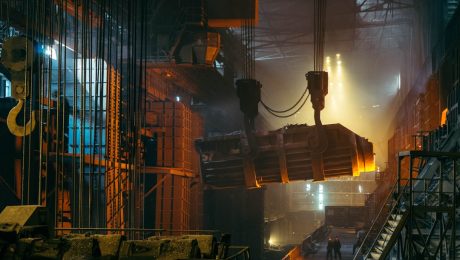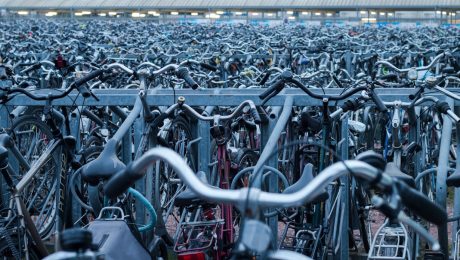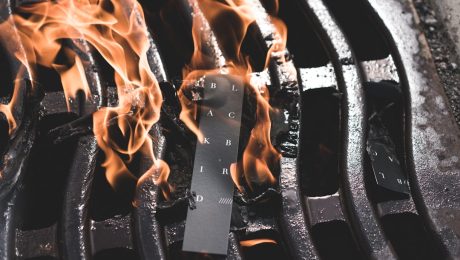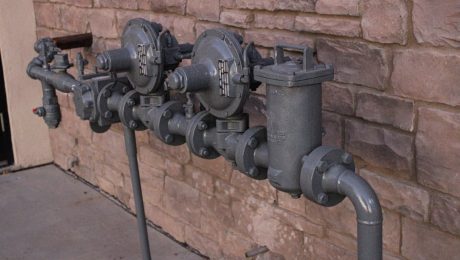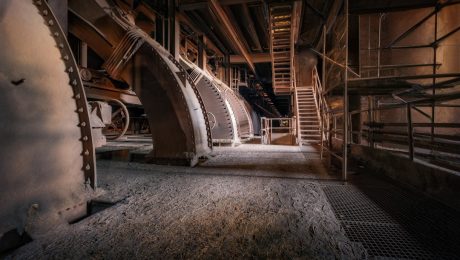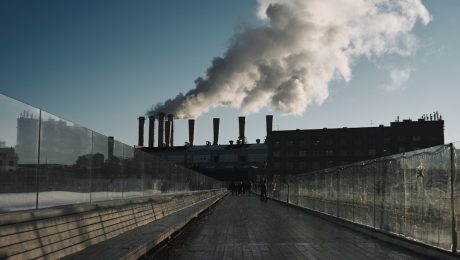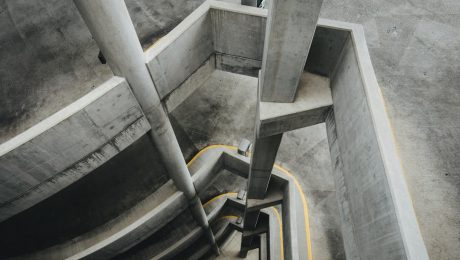Industrial pipes are the unsung heroes of manufacturing. These seemingly simple components play a crucial role in transporting vital fluids, gases, and slurries throughout a facility, impacting efficiency, safety, and the overall success of operations. Choosing the right industrial pipe for your specific needs is critical, and this guide will navigate you through the essential considerations.
Understanding Material Selection for Industrial Pipes
The material of your industrial pipe is paramount. The choice depends heavily on the substance being transported, the operating temperature and pressure, and the corrosive environment. Common materials include:
- Carbon Steel: A cost-effective and widely used option for applications with moderate pressures and temperatures. It’s strong and durable but susceptible to corrosion in certain environments.
- Stainless Steel: Offers superior corrosion resistance compared to carbon steel, making it ideal for handling chemicals, acids, and other corrosive substances. Different grades (like 304 and 316) offer varying levels of corrosion resistance.
- Cast Iron: Provides excellent strength and durability, often used in wastewater and drainage systems. However, it’s more brittle than steel.
- Ductile Iron: A superior alternative to cast iron, offering greater strength and ductility, making it less prone to breakage under stress.
- Plastic Pipes (PVC, CPVC, HDPE): Lightweight, corrosion-resistant, and cost-effective for applications involving less demanding pressures and temperatures. They are commonly used for chemical handling and water distribution.
- Copper: Excellent corrosion resistance and thermal conductivity, suitable for potable water systems and applications requiring heat transfer.
Careful consideration of the material properties in relation to your specific application is essential to prevent costly failures and ensure operational safety.
Industrial Pipe Applications Across Manufacturing Sectors
The applications of industrial pipes are vast and diverse across various manufacturing sectors. Here are some key examples:
- Chemical Processing: Pipes transport corrosive chemicals, requiring materials like stainless steel, PVC, or CPVC to withstand chemical degradation.
- Food and Beverage: Stainless steel pipes are preferred for their hygiene and corrosion resistance, ensuring the purity of food products.
- Pharmaceutical Manufacturing: Stringent hygiene standards necessitate the use of materials like stainless steel or specialized polymers to prevent contamination.
- Oil and Gas: High-pressure and high-temperature applications often require specialized steel alloys with enhanced strength and corrosion resistance.
- Power Generation: Pipes transport steam, water, and other fluids in power plants, requiring materials capable of withstanding high temperatures and pressures.
- Water Treatment: Ductile iron and PVC pipes are commonly used in water distribution and wastewater management systems.
Understanding the specific demands of each industry helps in selecting the appropriate pipe material and design.
Ensuring Safety and Compliance with Industrial Pipe Installations
Safety is paramount in industrial pipe installations. Improper installation can lead to leaks, explosions, and other hazardous situations. Key safety considerations include:
- Proper Welding and Joining Techniques: Ensuring strong and leak-proof connections is crucial, requiring skilled welders and appropriate techniques.
- Regular Inspections and Maintenance: Periodic inspections help identify potential issues like corrosion, leaks, or damage before they escalate into major problems.
- Pressure Testing: Testing pipes to ensure they can withstand the intended operating pressure is a critical step before commissioning.
- Compliance with Industry Standards and Regulations: Adhering to relevant codes and standards (like ASME, ASTM) is crucial for ensuring safety and legal compliance.
- Proper Support and Restraints: Pipes need adequate support to prevent sagging, vibration, and potential damage.
- Emergency Shutdown Procedures: Having clear and effective procedures in place for handling leaks or other emergencies is essential.
A proactive approach to safety is essential for preventing accidents and ensuring a safe working environment.
Factors to Consider When Selecting Industrial Pipes
Selecting the right industrial pipe involves considering various factors beyond just the material. These include:
- Pipe Diameter and Schedule: The diameter determines the flow capacity, while the schedule indicates the pipe’s wall thickness and pressure rating.
- Operating Temperature and Pressure: The pipe material must be able to withstand the expected temperature and pressure conditions.
- Fluid Compatibility: The pipe material must be compatible with the fluid being transported to prevent corrosion or chemical reactions.
- Installation Method: The chosen pipe material and diameter will influence the installation method, including welding, threading, or gluing.
- Cost and Availability: Balancing cost-effectiveness with performance and longevity is crucial.
- Maintenance Requirements: Some materials require more frequent maintenance than others.
A thorough evaluation of these factors ensures the selection of a pipe system that meets the specific needs of the application and optimizes performance and longevity.
The Future of Industrial Piping in Manufacturing
The industrial piping landscape is constantly evolving. Advancements in materials science are leading to the development of new materials with enhanced properties, such as improved corrosion resistance, higher temperature tolerance, and increased strength. Smart piping systems incorporating sensors and data analytics are also emerging, allowing for real-time monitoring of pipe conditions and predictive maintenance. This leads to improved efficiency, reduced downtime, and enhanced safety within manufacturing processes.
Furthermore, sustainability is becoming increasingly important. Manufacturers are exploring the use of recycled materials and more environmentally friendly piping solutions to reduce their environmental footprint. The future of industrial piping lies in the development of innovative and sustainable solutions that meet the evolving needs of the manufacturing industry.
Choosing the right industrial pipe is a critical decision with far-reaching implications for your manufacturing process. By carefully considering the factors outlined above, you can ensure the selection of a reliable, safe, and efficient piping system that supports the success of your operations.
Tags: Industrial Pipes, Manufacturing Pipes, Pipe Selection, Industrial Piping Systems, Pipe Materials
The phrase “000 ton/year production capacity” might seem like a simple statement of output, but it holds significant implications for any business. Understanding this figure requires a multifaceted approach, considering operational efficiency, market demand, financial projections, and future scalability. This post delves into the various aspects of a 000 ton/year production capacity, offering a comprehensive analysis of its meaning and impact.
Defining 000 Ton/Year Production Capacity: What Does it Mean?
A production capacity of 000 tons per year signifies the maximum amount of a specific product a company can produce within a 365-day period, assuming optimal operational conditions. This figure isn’t static; it’s influenced by factors like available resources (raw materials, machinery, labor), operational efficiency, and production downtime. For example, a factory with a 000 ton/year capacity for steel might achieve this output through continuous operation with minimal interruptions. However, unforeseen circumstances like equipment malfunction or supply chain disruptions can significantly reduce actual output. Therefore, it’s crucial to differentiate between theoretical maximum capacity and the actual, realized production.
Scaling Operations: The Challenges of Reaching and Maintaining 000 Ton/Year Production
Reaching a 000 ton/year production capacity often requires significant investment in infrastructure, technology, and personnel. This includes procuring advanced machinery, establishing efficient supply chains, hiring and training skilled workers, and implementing robust quality control systems. Scaling operations to this level demands meticulous planning and execution. Companies need to carefully assess their current infrastructure and identify potential bottlenecks. For instance, insufficient storage capacity, inadequate transportation infrastructure, or limitations in energy supply can hinder the ability to reach the target production level. Moreover, maintaining this capacity requires ongoing investment in maintenance, upgrades, and employee training to prevent production disruptions and ensure consistent output.
Market Analysis: Is 000 Ton/Year Production Sustainable?
Before investing in infrastructure to achieve a 000 ton/year production capacity, thorough market analysis is essential. This involves assessing current market demand for the product, identifying potential competitors, analyzing pricing strategies, and forecasting future market trends. A 000 ton/year capacity is only sustainable if there’s sufficient market demand to absorb the produced goods. Overproduction can lead to inventory buildup, price reductions, and ultimately, financial losses. Conversely, underestimating market demand can result in lost sales opportunities and reduced profitability. Therefore, a robust market analysis is crucial for determining the viability and long-term sustainability of a 000 ton/year production capacity.
Financial Implications: The Cost of Achieving and Maintaining Capacity
Achieving and maintaining a 000 ton/year production capacity comes with substantial financial implications. The initial investment can be significant, encompassing costs associated with new equipment, facility expansion, employee recruitment and training, and supply chain development. Ongoing operational costs, including raw materials, utilities, maintenance, and labor, also need to be factored into the financial projections. Companies must develop a comprehensive financial model that accurately predicts revenue streams, operational expenses, and profitability at this production level. Securing funding through loans, equity investment, or other financial instruments might be necessary to support the ambitious expansion.
Future-Proofing: Adaptability and Expansion Beyond 000 Ton/Year
While achieving a 000 ton/year production capacity is a significant milestone, businesses must also consider future scalability and adaptability. Market conditions can change rapidly, requiring companies to adjust their production capacity accordingly. Therefore, the infrastructure should be designed with future expansion in mind, allowing for easy upgrades and modifications. This might involve modular design principles, flexible production lines, and the adoption of advanced technologies that can be easily integrated into the existing system. Furthermore, companies should develop strategies to respond to changing market demands, such as diversifying product lines or exploring new market segments to ensure long-term sustainability and growth beyond the initial 000 ton/year target.
In conclusion, understanding the implications of a 000 ton/year production capacity requires a holistic approach, encompassing operational efficiency, market analysis, financial planning, and future scalability. By carefully considering these aspects, businesses can make informed decisions that maximize their chances of success.
Tags: production capacity, manufacturing capacity, scaling operations, market analysis, financial projections
The steel industry, a cornerstone of global infrastructure and manufacturing, is undergoing a significant transformation. One area experiencing rapid innovation is steel quoting. Traditionally a time-consuming and error-prone process, steel quoting is now being revolutionized by the integration of Artificial Intelligence (AI). AI-assisted steel quoting tools are streamlining operations, improving accuracy, and boosting profitability for businesses of all sizes. This post delves into the specifics of this exciting development.
1. The Challenges of Traditional Steel Quoting
Before the advent of AI, steel quoting was a complex and laborious task. It involved manually gathering data from multiple sources, including: steel mills’ price lists (which are often inconsistent and change frequently), transportation costs (influenced by fuel prices and distances), processing fees, and various other associated charges. This manual process was prone to human error, leading to inaccurate quotes and potentially lost business. Moreover, the time spent on quoting often diverted resources from other crucial business functions, hindering overall efficiency and profitability. The sheer volume of data required for accurate quoting also presented a significant challenge, making it difficult for businesses to keep up with market fluctuations and maintain a competitive edge.
2. How AI Streamlines the Steel Quoting Process
AI-assisted steel quoting tools address these challenges head-on. These tools leverage machine learning algorithms to automate various aspects of the quoting process. They can access and process vast amounts of data from diverse sources in real-time, including live market prices, inventory levels, transportation data, and even historical sales data. This automated data aggregation significantly reduces the risk of human error and ensures that quotes are based on the most up-to-date information. Furthermore, AI algorithms can identify patterns and trends in the data, enabling more accurate price predictions and helping businesses optimize their pricing strategies.
3. Key Features of AI-Assisted Steel Quoting Tools
Modern AI-powered steel quoting tools offer a range of features designed to enhance efficiency and accuracy. These typically include:
- Real-time Price Updates: Automatic updates from various steel mills and market data providers.
- Automated Calculations: Instantaneous calculation of total cost, including material, processing, and transportation expenses.
- Customizable Templates: Pre-designed templates for different types of steel products and customer segments.
- Inventory Management Integration: Real-time tracking of inventory levels to ensure accurate availability information.
- Predictive Analytics: Forecasting future steel prices and demand to aid in strategic decision-making.
- CRM Integration: Seamless integration with customer relationship management systems for improved customer service.
- Reporting and Analytics Dashboards: Detailed reports and visualizations to track quoting performance and identify areas for improvement.
4. Benefits of Implementing AI-Assisted Steel Quoting Tools
The adoption of AI-assisted steel quoting tools offers numerous benefits for businesses in the steel industry. These include:
- Increased Efficiency: Automation significantly reduces the time and effort required for quoting, freeing up valuable resources.
- Improved Accuracy: Minimizes human error, leading to more accurate and reliable quotes.
- Enhanced Profitability: Optimized pricing strategies and reduced operational costs contribute to higher profit margins.
- Better Customer Service: Faster quote turnaround times and improved accuracy enhance customer satisfaction.
- Competitive Advantage: Provides a competitive edge by enabling quicker and more accurate responses to customer inquiries.
- Data-Driven Decision Making: Access to comprehensive data and analytics facilitates informed business decisions.
5. The Future of AI in Steel Quoting
The integration of AI in steel quoting is still in its relatively early stages, but the potential for future advancements is immense. We can expect to see even more sophisticated tools emerge, incorporating features such as:
- Advanced Predictive Modeling: More accurate forecasting of steel prices and demand, considering a wider range of factors.
- Increased Automation: Further automation of tasks, such as contract generation and order processing.
- Integration with Supply Chain Management: Seamless integration with broader supply chain systems for end-to-end optimization.
- Blockchain Technology Integration: Enhanced transparency and security in transactions.
- Personalized Quoting: Tailored quotes based on individual customer preferences and needs.
As AI technology continues to evolve, we can anticipate even more transformative changes in the steel quoting process, leading to greater efficiency, accuracy, and profitability for businesses across the industry.
Tags: AI steel quoting, steel quoting software, AI in steel industry, automated steel quotes, steel price prediction
Waste heat recovery (WHR) is a crucial strategy for improving energy efficiency and reducing environmental impact across various industries. While the overall system design is complex, the humble pipe plays a surprisingly significant role in the success of any WHR project. The choice of pipe material, its design, installation, and ongoing maintenance directly impact the efficiency and longevity of the entire heat recovery system. This post delves into the critical aspects of pipes within WHR projects, offering insights for engineers, project managers, and anyone interested in sustainable energy solutions.
1. Material Selection: The Foundation of Efficient Heat Transfer
The selection of pipe material is paramount in WHR. The material must withstand the high temperatures and pressures involved, resist corrosion from the waste heat stream, and possess high thermal conductivity to facilitate efficient heat transfer. Several materials are commonly employed, each with its own advantages and disadvantages:
- Stainless Steel: A popular choice due to its excellent corrosion resistance, high strength, and relatively good thermal conductivity. Different grades of stainless steel are available, allowing for selection based on specific temperature and pressure requirements. However, stainless steel can be expensive.
- Carbon Steel: A cost-effective option, but susceptible to corrosion, especially in high-temperature environments with aggressive fluids. Often requires protective coatings or linings to extend its lifespan.
- Copper: Excellent thermal conductivity makes copper an attractive option, but its cost and susceptibility to certain corrosive agents limit its applications.
- High-Performance Polymers (e.g., PEEK, PTFE): Suitable for lower temperature applications and situations where chemical compatibility is crucial. These materials offer excellent corrosion resistance but may have lower thermal conductivity compared to metals.
- Ceramic Pipes: Used in extremely high-temperature applications where other materials fail. They offer excellent thermal resistance but are brittle and require careful handling and installation.
The choice of material depends heavily on the specific waste heat stream’s characteristics (temperature, pressure, chemical composition), the required heat transfer rate, and the overall project budget.
2. Pipe Design and Sizing: Optimizing Heat Transfer and Minimizing Pressure Drop
Pipe design goes beyond material selection. The diameter, length, and configuration of the pipes significantly influence the system’s efficiency. Proper sizing is crucial to balance heat transfer and pressure drop. Smaller diameter pipes offer higher heat transfer rates due to increased surface area to volume ratio, but also lead to higher pressure drops, requiring more powerful pumps. Larger diameter pipes reduce pressure drop but decrease the heat transfer rate. Computational Fluid Dynamics (CFD) simulations are often used to optimize pipe design and minimize energy losses.
Furthermore, the pipe configuration itself can impact efficiency. Using multiple smaller pipes in parallel can increase the overall heat transfer area compared to a single large pipe. The arrangement of pipes within the heat exchanger also needs careful consideration to ensure uniform flow and optimal heat transfer.
3. Insulation: Reducing Heat Loss and Enhancing Efficiency
Insulating the pipes is critical to minimize heat loss to the surroundings and maximize the amount of recovered heat. The choice of insulation material depends on the operating temperature and environmental conditions. Common insulation materials include fiberglass, mineral wool, calcium silicate, and polyurethane foam. The thickness of the insulation layer is determined by balancing cost and performance. Thicker insulation reduces heat loss but increases material and installation costs. Proper installation of insulation is crucial to prevent thermal bridges and ensure consistent performance.
The insulation’s thermal conductivity and its ability to withstand the operating temperature are key factors to consider. Regular inspection and maintenance of the insulation are essential to prevent degradation and ensure continued efficiency.
4. Pipe Connections and Fittings: Ensuring Leak-Free and Efficient Operation
Proper pipe connections and fittings are vital for a leak-free and efficient system. The choice of fittings depends on the pipe material and operating conditions. Flanges, threaded connections, and welding are common methods used for joining pipes. Each method has its advantages and disadvantages in terms of cost, ease of installation, and suitability for different operating pressures and temperatures. Leakage in the system can lead to significant energy losses and safety hazards.
Regular inspection and maintenance of pipe connections are critical to prevent leaks and ensure the long-term reliability of the WHR system. Proper torqueing of bolts, regular leak checks, and timely replacement of damaged fittings are crucial preventative measures.
5. Maintenance and Inspection: Extending the Lifespan and Optimizing Performance
Regular inspection and maintenance are essential for maximizing the lifespan and efficiency of the pipes in a WHR system. This includes visual inspections for corrosion, leaks, and damage to the insulation. Regular cleaning of the pipes can remove deposits that can reduce heat transfer efficiency. Non-destructive testing methods, such as ultrasonic testing, can be used to detect internal corrosion or defects without dismantling the system.
A well-defined maintenance schedule, including regular inspections and preventative maintenance tasks, is crucial to minimize downtime and ensure the long-term performance of the WHR system. This proactive approach can significantly reduce the risk of unexpected failures and costly repairs.
In conclusion, the seemingly simple pipe plays a crucial, multifaceted role in the success of waste heat recovery projects. Careful consideration of material selection, design, insulation, connections, and maintenance practices is essential for optimizing efficiency, minimizing energy losses, and ensuring the long-term viability of these environmentally friendly and cost-effective initiatives.
SEO Tags: Waste Heat Recovery, Pipes in WHR, Heat Exchanger Pipes, Pipe Insulation, WHR Maintenance
Oil refineries are complex and hazardous environments, demanding materials that can withstand extreme pressures, temperatures, and corrosive chemicals. At the heart of this intricate network lies a seemingly simple yet crucial component: steel pipes. These seemingly unassuming conduits are the arteries of the refinery, transporting a vast array of fluids and gases throughout the process. This blog post delves into the vital role of steel pipes in oil refineries, exploring their types, applications, safety considerations, and future trends.
Types of Steel Pipes Used in Oil Refineries
The choice of steel pipe depends heavily on the specific application and the properties of the substance being transported. Several types are commonly employed:
- Carbon Steel Pipes: These are the most widely used due to their strength, durability, and relatively low cost. Different grades of carbon steel are selected based on the required yield strength, tensile strength, and resistance to corrosion. Common grades include ASTM A53, A106, and A333.
- Stainless Steel Pipes: Where corrosion resistance is paramount, stainless steel pipes are preferred. They are particularly crucial in handling highly corrosive substances or in environments with high humidity or exposure to saltwater. Common grades include 304, 316, and 317L.
- Alloy Steel Pipes: For applications requiring enhanced strength at high temperatures or resistance to specific chemicals, alloy steel pipes are employed. These pipes contain alloying elements like chromium, molybdenum, and nickel to improve their properties. Examples include chromium-molybdenum (Cr-Mo) steel pipes.
- Seamless vs. Welded Pipes: Both seamless and welded pipes find applications in refineries. Seamless pipes are generally preferred for high-pressure applications due to their superior strength and lack of weld seams, which can be potential points of failure. Welded pipes, while less expensive, are suitable for lower-pressure applications.
Applications of Steel Pipes Across Refinery Processes
Steel pipes are integral to virtually every stage of the refining process. Their applications include:
- Crude Oil Transfer: Large-diameter pipes transport crude oil from storage tanks to the processing units.
- Fractionation Columns: Smaller diameter pipes carry various fractions (gasoline, kerosene, diesel, etc.) from the fractionation columns.
- Heat Exchangers: Pipes form the core of heat exchangers, facilitating the transfer of heat between different streams.
- Reactors and Catalytic Converters: Specialized pipes, often made of alloy steel, are used in reactors and converters where high temperatures and pressures are involved.
- Pipelines and Distribution Networks: Extensive pipeline networks utilize steel pipes to distribute refined products throughout the refinery and to offsite storage and transportation facilities.
Ensuring Safety and Integrity of Steel Pipes in Refineries
The safety implications of pipe failure in a refinery are severe. Therefore, stringent measures are implemented to ensure the integrity of the steel pipes:
- Regular Inspections and Maintenance: Routine inspections, including visual checks, ultrasonic testing (UT), and radiographic testing (RT), are crucial to detect potential defects early.
- Pressure Testing: Hydrostatic testing is performed to verify the pipe’s ability to withstand the operating pressures.
- Corrosion Control: Various methods, such as coatings, cathodic protection, and inhibitors, are used to mitigate corrosion.
- Proper Installation and Welding: Skilled welders and strict adherence to welding procedures are vital to ensure the integrity of welded joints.
- Emergency Shutdown Systems: Robust emergency shutdown systems are in place to quickly isolate sections of the piping system in case of leaks or failures.
Pipe Specifications and Material Selection in Refinery Design
The selection of appropriate steel pipes is a critical aspect of refinery design. Engineers must consider several factors:
- Fluid Properties: The chemical composition, temperature, and pressure of the fluid being transported dictate the required material properties.
- Operating Conditions: Temperature fluctuations, pressure variations, and the presence of corrosive substances influence the choice of steel grade.
- Industry Standards and Codes: Adherence to relevant industry standards, such as ASME, API, and ASTM, ensures the safety and reliability of the piping system.
- Cost Considerations: While safety is paramount, cost-effectiveness is also a factor in material selection. A balance between performance and cost is sought.
- Maintenance and Replaceability: The ease of maintenance and replacement of the pipes is also considered during the design phase.
Future Trends in Steel Pipe Technology for Oil Refineries
The oil and gas industry is constantly evolving, and so too is the technology used in its infrastructure. Future trends include:
- Advanced Materials: Research is ongoing into new steel alloys with enhanced corrosion resistance and high-temperature strength.
- Smart Pipes and Monitoring Systems: Sensors embedded within pipes can monitor pressure, temperature, and corrosion levels in real-time, enabling predictive maintenance.
- Improved Welding Techniques: Advanced welding technologies, such as laser welding, aim to improve the quality and efficiency of pipe joining.
- Sustainable Practices: The industry is increasingly focusing on sustainable practices, including the use of recycled steel and reducing the environmental impact of pipe manufacturing and disposal.
- Digital Twins and Simulation: Digital twins of refinery piping systems can be used for virtual testing and optimization, improving safety and efficiency.
In conclusion, steel pipes are indispensable components of oil refineries, playing a critical role in the safe and efficient operation of these complex facilities. Understanding their types, applications, safety considerations, and future trends is essential for engineers, operators, and anyone involved in the petroleum industry.
Tags: steel pipes, oil refinery, petroleum industry, carbon steel pipes, stainless steel pipes
From electricity generation to industrial processes, boiler tubes are the unsung heroes powering our modern world. These seemingly simple components play a critical role in efficient heat transfer, ultimately driving countless applications. This comprehensive guide delves into the technology and use of boiler tubes, exploring their materials, design, maintenance, and future prospects.
The Science of Heat Transfer in Boiler Tubes
The primary function of a boiler tube is to facilitate the efficient transfer of heat from the combustion process to the water or steam within the boiler. This heat transfer is predominantly achieved through convection and conduction. Convection involves the movement of heated fluid (water/steam) within the tube, while conduction refers to the transfer of heat through the tube’s material itself. The design of the boiler tube, including its diameter, length, and material properties, directly impacts the rate and efficiency of this heat transfer. Factors like tube wall thickness and surface area are crucial in optimizing heat transfer performance. A well-designed tube minimizes thermal resistance, ensuring maximum heat absorption and steam generation.
Boiler Tube Materials: A Balancing Act of Strength and Durability
The choice of boiler tube material is paramount, demanding a delicate balance between strength, corrosion resistance, and high-temperature performance. Common materials include carbon steel, alloy steel, and stainless steel, each suited to specific operating conditions and applications. Carbon steel is cost-effective and suitable for lower-pressure boilers, but its corrosion resistance is limited. Alloy steels, incorporating elements like chromium, molybdenum, and vanadium, offer enhanced strength and creep resistance at elevated temperatures, crucial for high-pressure and high-temperature applications. Stainless steels, particularly those with high chromium content, provide excellent corrosion resistance, making them ideal for boilers handling aggressive chemicals or corrosive flue gases.
The selection process often involves considering factors like boiler pressure, temperature, fuel type, and the chemical composition of the water and steam. Advanced materials, such as superalloys, are employed in specialized applications requiring exceptionally high temperatures and pressures, such as those found in power plants utilizing advanced combustion technologies.
Boiler Tube Design and Manufacturing: Precision Engineering for Optimal Performance
Boiler tube manufacturing involves rigorous quality control to ensure dimensional accuracy, surface finish, and material integrity. Seamless tubes are often preferred for high-pressure applications to eliminate potential weld defects. The manufacturing process involves various techniques, including hot rolling, cold drawing, and heat treatment. Heat treatment is essential to achieve the desired mechanical properties, such as strength, ductility, and toughness. The precise dimensions and tolerances of the tubes are critical to ensure proper fitting within the boiler header and drum assemblies. Advanced manufacturing techniques, such as precision welding and advanced surface treatments, are continuously being developed to improve tube lifespan and performance.
Maintenance and Inspection of Boiler Tubes: Prolonging Lifespan and Ensuring Safety
Regular maintenance and inspection of boiler tubes are crucial for ensuring safe and efficient operation. This involves visual inspection for signs of corrosion, erosion, scaling, and other defects. Non-destructive testing (NDT) methods, such as ultrasonic testing and eddy current testing, are employed to detect internal flaws that might not be visible to the naked eye. Regular chemical cleaning of the tubes helps remove scale buildup, improving heat transfer efficiency and preventing corrosion. Proper water treatment is also essential to minimize scale formation and corrosion. Early detection and repair of defects can significantly extend the lifespan of boiler tubes and prevent catastrophic failures.
Future Trends in Boiler Tube Technology: Innovation for Enhanced Efficiency and Sustainability
Ongoing research and development efforts are focused on improving the efficiency, durability, and sustainability of boiler tubes. This includes the development of advanced materials with enhanced high-temperature strength and corrosion resistance. Innovative designs, such as finned tubes and advanced geometries, are being explored to improve heat transfer efficiency. The use of advanced manufacturing techniques, such as additive manufacturing (3D printing), offers the potential for customized designs and improved manufacturing efficiency. Furthermore, research into more sustainable materials and manufacturing processes is gaining momentum to reduce the environmental impact of boiler tube production and disposal.
In conclusion, boiler tubes are essential components in numerous industrial applications, demanding robust design, durable materials, and meticulous maintenance. The ongoing advancements in material science and manufacturing technologies ensure the continued reliability and efficiency of these unsung heroes of power generation.
SEO Tags:
- Boiler Tubes
- Boiler Tube Technology
- Heat Transfer in Boilers
- Boiler Tube Materials
- Boiler Maintenance
The humble square. A simple shape, yet one brimming with mathematical elegance and cultural significance. From the perfectly aligned corners of a chessboard to the imposing architecture of ancient civilizations, the square’s influence is pervasive. This exploration delves into the multifaceted world of the square, revealing its hidden depths and surprising versatility.
Defining the Square: A Geometric Perspective
In the realm of geometry, a square is defined as a quadrilateral – a two-dimensional shape with four sides – possessing several crucial characteristics. These defining features are its four right angles (each measuring 90 degrees), and its four sides of equal length. This perfect symmetry is what sets the square apart from other quadrilaterals like rectangles and rhombuses. The equality of sides and the presence of right angles lead to a host of unique mathematical properties, making the square a foundational element in geometry and a stepping stone to understanding more complex shapes.
Calculating Area and Perimeter: Practical Applications of the Square
The simplicity of the square’s definition translates to straightforward formulas for calculating its area and perimeter. The perimeter, the total distance around the square, is simply four times the length of one side (P = 4s). The area, the amount of space enclosed within the square, is calculated by squaring the length of one side (A = s²). These formulas are fundamental in various practical applications, from calculating the amount of tile needed to cover a floor to determining the size of a plot of land. Understanding these calculations is crucial in fields ranging from construction and engineering to interior design and land surveying. Beyond simple calculations, these formulas provide a base for understanding more complex area and perimeter calculations for other shapes.
Squares in Art, Architecture, and Culture: A Symbol of Stability and Harmony
The square’s inherent symmetry and stability have made it a powerful symbol throughout history and across diverse cultures. In art, the square often represents order, balance, and rationality. Think of the perfectly proportioned squares in Renaissance paintings or the grid-like structures used in many forms of design. In architecture, the square is a ubiquitous element, from the perfectly square windows of ancient Roman buildings to the imposing square towers of medieval castles. The square’s presence often signifies strength, permanence, and a sense of groundedness. Its use in architecture and design continues to this day, reflecting its enduring appeal and practicality. The symbolic weight of the square varies across cultures, but its association with stability and order remains a consistent theme.
Squares in Mathematics: Beyond the Basics
The square’s significance extends far beyond its simple geometric definition. In mathematics, it serves as a building block for more advanced concepts. The concept of “squaring” a number (multiplying a number by itself) is directly related to the area calculation of a square. This fundamental operation is crucial in algebra, calculus, and numerous other branches of mathematics. Furthermore, the square’s properties are essential in understanding concepts like Pythagorean theorem (a² + b² = c²), where the square of the hypotenuse of a right-angled triangle is equal to the sum of the squares of the other two sides. This theorem itself has countless applications in various fields, highlighting the square’s foundational role in mathematical thought.
Exploring the Square’s Relatives: Rectangles, Cubes, and Beyond
The square’s unique properties provide a foundation for understanding related geometric shapes. A rectangle, for instance, shares some similarities with a square (four right angles), but its sides are not necessarily equal in length. The square can be extended into three dimensions to form a cube, a three-dimensional shape with six identical square faces. Understanding the square’s relationship to these shapes allows for a deeper grasp of geometric principles and their applications. The progression from a square to a rectangle to a cube illustrates the interconnectedness of geometric concepts and the building-block nature of simple shapes in constructing more complex forms. This interconnectedness extends into more abstract mathematical concepts as well.
In conclusion, the square, despite its apparent simplicity, is a shape of remarkable depth and significance. Its mathematical properties, cultural symbolism, and diverse applications across various fields highlight its enduring importance in our understanding of the world around us. From the basic calculations of area and perimeter to its role in advanced mathematical concepts and artistic expression, the square continues to fascinate and inspire.
Tags: square, geometry, mathematics, area, perimeter, symbolism
body {
font-family: sans-serif;
line-height: 1.6;
}
h1, h2, h3 {
color: #333;
}
The steel industry is a significant contributor to global greenhouse gas emissions. Understanding and accurately reporting these emissions is crucial for driving decarbonization efforts and meeting climate targets. This comprehensive guide provides a detailed look into the complexities of carbon emission reporting within the steel sector.
Scope 1, 2, and 3 Emissions in Steel Production
Accurately reporting carbon emissions requires understanding the different scopes defined by the Greenhouse Gas Protocol. In the steel industry, these scopes encompass a wide range of activities:
- Scope 1: Direct Emissions – These are emissions directly from owned or controlled sources. In steel production, this includes emissions from coke ovens (a significant source of CO2 and other greenhouse gases), direct combustion in steelmaking processes (e.g., blast furnaces), and fugitive emissions from equipment leaks.
- Scope 2: Indirect Emissions from Energy Consumption – These emissions result from the generation of purchased electricity, heat, or steam used in steel production. This often represents a substantial portion of a steel company’s carbon footprint, depending on the energy mix used by the electricity provider.
- Scope 3: Other Indirect Emissions – This is the most complex category and encompasses all other indirect emissions not included in Scope 1 or 2. In steel production, this includes emissions from:
- Upstream activities: Raw material extraction (iron ore mining, coal mining), transportation of raw materials, manufacturing of purchased goods and services.
- Downstream activities: Transportation of steel products, use of steel products by customers (e.g., embodied carbon in buildings), and end-of-life treatment of steel products.
- Business travel and employee commuting: Emissions from employee business travel and commuting to and from work.
Calculating Steel’s Carbon Footprint: Methods and Data
Accurate calculation of steel’s carbon footprint requires meticulous data collection and the application of appropriate methodologies. Common methods include:
- Process-based accounting: This involves quantifying emissions from each stage of the steel production process, using emission factors specific to the technologies and fuels employed. This requires detailed knowledge of the production process and energy consumption data.
- Activity data-based accounting: This approach uses activity data (e.g., amount of steel produced, energy consumed) and emission factors to calculate emissions. This method is less detailed than process-based accounting but can be more efficient for initial assessments.
- Life Cycle Assessment (LCA): LCA provides a comprehensive analysis of the environmental impacts of a product throughout its entire life cycle, from raw material extraction to end-of-life disposal. It offers a holistic view of the steel’s carbon footprint but requires substantial data and expertise.
Data sources can include operational records, energy bills, supplier data, and industry-specific emission factors.
Reporting Frameworks and Standards for Steel Emissions
Several reporting frameworks and standards guide the reporting of greenhouse gas emissions. The most prominent include:
- Greenhouse Gas Protocol: This widely recognized standard provides a comprehensive framework for measuring and reporting greenhouse gas emissions, including the three scopes mentioned above.
- Carbon Disclosure Project (CDP): CDP is a non-profit organization that encourages companies to disclose their environmental impacts, including greenhouse gas emissions. Many steel companies participate in CDP’s reporting process.
- Sustainability Accounting Standards Board (SASB): SASB develops industry-specific sustainability standards, including those relevant to the steel industry. These standards provide guidance on the material environmental issues that investors consider important.
- Task Force on Climate-related Financial Disclosures (TCFD): The TCFD recommends a framework for companies to disclose climate-related risks and opportunities, including greenhouse gas emissions and climate change mitigation strategies.
Challenges and Best Practices in Steel Emission Reporting
Accurate and transparent emission reporting in the steel industry faces several challenges:
- Data availability and quality: Collecting accurate and complete data across the entire value chain can be difficult, especially for Scope 3 emissions.
- Data consistency and comparability: Different methodologies and data sources can lead to inconsistencies in emission reporting, making comparisons between companies challenging.
- Complexity of Scope 3 emissions: Accurately accounting for Scope 3 emissions requires engaging with numerous stakeholders throughout the supply chain, which can be time-consuming and complex.
- Evolving technologies and methodologies: The steel industry is undergoing significant technological changes, requiring updates to emission factors and calculation methodologies.
Best practices include:
- Establish a robust data management system: Implement a system to effectively collect, manage, and analyze emission data.
- Collaborate with stakeholders: Work with suppliers, customers, and other stakeholders to collect data for Scope 3 emissions.
- Employ appropriate methodologies: Select calculation methodologies that are appropriate for the level of detail and accuracy required.
- Regularly review and update reporting processes: Stay updated on the latest standards and methodologies and regularly review and update reporting processes to ensure accuracy and completeness.
The Future of Carbon Reporting in the Steel Industry
The future of carbon reporting in the steel industry will be shaped by several factors:
- Increased regulatory pressure: Governments worldwide are implementing stricter regulations on greenhouse gas emissions, requiring more detailed and transparent reporting.
- Investor demand for transparency: Investors are increasingly demanding greater transparency on climate-related risks and opportunities, including greenhouse gas emissions.
- Technological advancements: New technologies, such as carbon capture, utilization, and storage (CCUS), will significantly impact the industry’s carbon footprint and reporting practices.
- Standardization and harmonization: Efforts to standardize and harmonize reporting methodologies will improve data comparability and transparency.
Accurate and transparent carbon emission reporting is essential for the steel industry to achieve its decarbonization goals and contribute to global climate action. By embracing best practices and adapting to evolving standards, steel companies can play a vital role in creating a more sustainable future.
Tags: Steel emissions, carbon footprint steel, greenhouse gas reporting, steel industry sustainability, carbon accounting steel
Steel, the backbone of modern infrastructure, is a marvel of material science. But its creation relies on a complex interplay of raw materials, each playing a crucial role in determining the final product’s properties. This comprehensive guide delves into the diverse sources of these essential components, exploring their extraction, processing, and impact on the quality and characteristics of the steel we rely on daily.
1. Iron Ore: The Foundation of Steel
Iron ore, the primary raw material in steelmaking, is a naturally occurring rock or sediment that contains a significant amount of iron. The most common forms are hematite (Fe₂O₃), magnetite (Fe₃O₄), and limonite (FeO(OH)·nH₂O). These ores are extracted through various methods, primarily open-pit mining for large, easily accessible deposits and underground mining for deeper reserves. The extraction process involves blasting, crushing, and transporting the ore to processing plants. Here, the ore undergoes beneficiation, a process that involves crushing, grinding, and separating the iron-rich components from waste rock (gangue). This concentrates the iron content, increasing efficiency and reducing the energy required for steelmaking.
The quality of iron ore, specifically its iron content and the presence of impurities like silica, alumina, and phosphorus, significantly impacts the steel’s properties. High-grade ores with a higher iron content are preferred due to their lower processing costs and improved steel quality. The geographical distribution of iron ore deposits influences global steel production patterns, with major producers located in Australia, Brazil, China, India, and Russia.
2. Coal: The Fueling Force
Coal, a fossil fuel primarily composed of carbon, plays a vital role in steelmaking as the primary fuel source in blast furnaces and as a reducing agent in the ironmaking process. It provides the heat energy required to melt the iron ore and reduce the iron oxides to metallic iron. Coal’s quality, specifically its calorific value (energy content) and ash content (impurities), is crucial. High-quality coal with high calorific value and low ash content is preferred to maximize energy efficiency and minimize the formation of slag (waste material) during steelmaking.
The mining of coal, similar to iron ore, involves both surface and underground methods, depending on the deposit’s location and depth. Environmental concerns associated with coal mining and its combustion, such as greenhouse gas emissions and air pollution, are driving the steel industry to explore alternative energy sources and carbon capture technologies.
3. Scrap Metal: The Recycled Resource
Scrap metal, encompassing discarded steel and iron products, is a crucial secondary raw material in steelmaking. Its use significantly reduces the demand for virgin iron ore and coal, contributing to environmental sustainability and resource conservation. Scrap metal is collected from various sources, including demolition sites, automotive industries, and manufacturing plants. It’s then sorted, processed, and prepared for use in electric arc furnaces (EAFs), a major steelmaking process that utilizes scrap as its primary raw material.
The quality of scrap metal varies greatly depending on its source and composition. The presence of impurities and different steel grades can affect the final steel product’s properties. Therefore, careful sorting and processing of scrap metal are essential to ensure consistent steel quality. The increasing use of scrap metal in steelmaking represents a significant step towards a more circular economy.
4. Alloying Elements: Fine-Tuning Steel Properties
Alloying elements are added to steel to modify its mechanical, physical, and chemical properties. These elements include manganese, chromium, nickel, molybdenum, vanadium, and many others. Each element imparts specific characteristics to the steel, influencing its strength, hardness, ductility, corrosion resistance, and weldability. For instance, chromium enhances corrosion resistance (stainless steel), while nickel improves toughness and ductility.
These alloying elements are sourced from various minerals and ores through complex refining processes. Their addition to the steelmaking process is carefully controlled to achieve the desired properties. The precise composition of alloying elements is crucial in determining the final application of the steel, from construction and automotive components to medical implants and aerospace applications.
5. Fluxing Materials: Refining and Cleaning
Fluxing materials, such as limestone and dolomite, are essential in steelmaking to remove impurities from the molten iron and improve the efficiency of the process. These materials react with impurities like silica and alumina, forming slag, which floats on top of the molten iron and can be easily removed. The selection of fluxing materials depends on the composition of the iron ore and other raw materials used. The proper use of fluxing materials is vital for producing high-quality steel with desired chemical composition and mechanical properties.
The chemical reactions within the furnace, influenced by the fluxing materials, are critical in controlling the temperature, fluidity, and overall efficiency of the steelmaking process. Optimizing the use of fluxing materials contributes to cost reduction and environmental sustainability by minimizing waste and energy consumption.
Understanding the diverse sources and intricate interplay of raw materials is essential to appreciating the complexity and sophistication of steel production. Continuous innovation in sourcing, processing, and utilizing these materials will be key to ensuring a sustainable and efficient steel industry for the future.
SEO-Friendly Tags:
steel raw materials, iron ore mining, coal in steelmaking, scrap metal recycling, alloying elements steel
body { font-family: sans-serif; line-height: 1.6; }
h1, h2, h3 { color: #333; }
img { max-width: 100%; height: auto; }
Steel profiles are far more than just structural components in power plants; they are the backbone of these complex and critical facilities. From the towering structures of nuclear plants to the intricate frameworks of thermal power stations, steel profiles ensure stability, durability, and operational efficiency. This comprehensive guide explores the multifaceted role of steel profiles in the power generation industry.
1. The Diverse Applications of Steel Profiles in Power Plants
Steel profiles find applications across a vast spectrum within power plants. Their versatility allows them to serve in various crucial roles:
- Structural Support: Steel beams, columns, and channels form the foundational structure of power plant buildings, supporting massive equipment like turbines, generators, and boilers. Their high strength-to-weight ratio is crucial for minimizing the overall weight of the structure while maintaining exceptional load-bearing capacity.
- Equipment Frames and Supports: Precisely engineered steel profiles create robust frames for critical equipment, ensuring stability during operation and preventing vibrations from causing damage. This includes supports for transformers, switchgear, and cooling towers.
- Piping and Ductwork: Steel profiles are often incorporated into the design of complex piping systems and ductwork, providing structural support and preventing sagging or collapse under pressure. This is particularly crucial in high-temperature and high-pressure systems.
- Stairways and Platforms: Safe and efficient access to various levels within a power plant is vital. Steel profiles are commonly used in the construction of stairways, platforms, and walkways, ensuring worker safety and ease of maintenance.
- Crane Rails and Gantry Systems: Heavy lifting is an integral part of power plant operation. Steel profiles form the foundation of crane rails and gantry systems, providing a reliable and robust support structure for the movement of heavy components during construction and maintenance.
2. Material Selection: Choosing the Right Steel for the Job
The selection of appropriate steel profiles is crucial for ensuring the longevity and safety of a power plant. Factors influencing material selection include:
- Strength and Yield Strength: The ability of the steel to withstand high loads and stresses is paramount, especially in areas subjected to significant forces.
- Corrosion Resistance: Power plants often operate in harsh environments, exposed to moisture, chemicals, and extreme temperatures. Corrosion-resistant steels, such as stainless steel or galvanized steel, are often preferred to extend the lifespan of the structure.
- Temperature Resistance: In certain applications, particularly those involving high-temperature processes, specialized heat-resistant steels are necessary to prevent weakening or failure at elevated temperatures.
- Weldability: The ability of the steel to be easily and reliably welded is essential for efficient construction. The chosen steel must be compatible with the welding processes employed.
- Fatigue Resistance: Power plant components are subjected to cyclic loading and vibrations. Steel with high fatigue resistance is crucial to prevent premature failure due to fatigue cracking.
3. Manufacturing Processes and Quality Control
The manufacturing process of steel profiles for power plants requires meticulous precision and quality control. Common manufacturing techniques include:
- Hot Rolling: This process involves shaping heated steel billets into the desired profile using heavy rollers. It’s cost-effective for mass production of standard profiles.
- Cold Forming: Cold forming allows for greater precision and tighter tolerances, making it suitable for complex profiles. It also results in higher strength and improved surface finish.
- Extrusion: This method is employed for creating complex shapes and hollow sections, often used in specialized applications within power plants.
Rigorous quality control measures are implemented throughout the manufacturing process, including:
- Chemical Composition Analysis: Ensuring the steel meets the specified chemical composition for desired properties.
- Mechanical Testing: Verification of strength, yield strength, ductility, and other mechanical properties.
- Dimensional Inspection: Confirming that the profiles meet the required dimensions and tolerances.
- Non-Destructive Testing (NDT): Detecting internal flaws or defects without damaging the profile.
4. The Importance of Design and Engineering Considerations
The design and engineering of steel profile structures in power plants are critical for safety and operational efficiency. Key considerations include:
- Seismic Design: Power plants located in seismically active regions must be designed to withstand earthquake forces. Steel profiles are chosen for their resilience and ability to absorb seismic energy.
- Wind Loading: Tall structures like cooling towers require careful consideration of wind loads. The design must ensure stability and prevent damage from high winds.
- Thermal Expansion: Fluctuations in temperature can cause expansion and contraction of steel structures. Designers must account for this to prevent stress and damage.
- Corrosion Protection: Appropriate corrosion protection measures, such as coatings, galvanization, or cathodic protection, are essential to extend the lifespan of steel profiles in harsh environments.
- Fire Protection: Steel structures can be vulnerable to fire. Fire-resistant coatings or fireproofing systems may be necessary to protect the steel and ensure structural integrity in case of fire.
5. Future Trends and Innovations in Steel Profile Applications
The power generation industry is constantly evolving, leading to innovations in steel profile applications:
- High-Strength Steels: The development of high-strength steels allows for lighter and more efficient structures, reducing material costs and minimizing environmental impact.
- Advanced Manufacturing Techniques: New techniques like 3D printing and additive manufacturing offer the potential to create complex and customized steel profiles with enhanced performance.
- Smart Steel: The integration of sensors and monitoring systems into steel structures enables real-time condition monitoring, allowing for proactive maintenance and preventing unexpected failures.
- Sustainable Steel Production: The industry is focusing on reducing the carbon footprint of steel production, promoting the use of recycled steel and exploring more sustainable manufacturing processes.
In conclusion, steel profiles are integral to the design, construction, and operation of power plants worldwide. Their versatility, strength, and durability make them indispensable for ensuring the safety, reliability, and efficiency of these critical facilities. By understanding the diverse applications, material selection criteria, manufacturing processes, and design considerations, we can better appreciate the crucial role these seemingly simple components play in powering our world.
Tags:
Steel profiles, Power plants, Steel construction, Power generation, Structural steel

